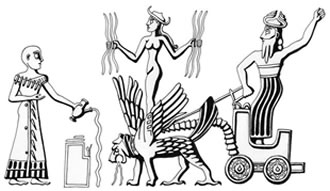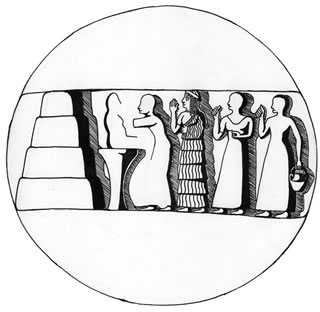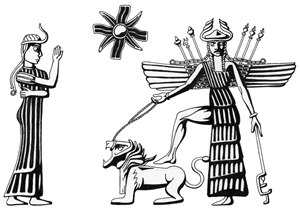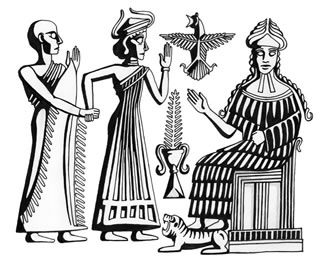

Inanna, Goddess of "Infinite Variety"
|
Enheduanna in
full regalia supervising ritual at altar before temple tower. Limestone
disk, from Ur, ca.2300 BCE, restored.
S. Beaulieu, after Meador 2000:38,13a. larger view of image |
"The Amazement of the Land [of Sumer],"[1] Inanna was a powerful and assertive goddess whose areas of control and influence included warfare, love/sexuality, and prosperity/fertility. As "Lady Who Ascends into the Heavens," she was the Venus Star. One of her regular epithets was "the maiden," and her usual roles -- little sister and pert daughter, sweetheart, nubile bride, and grief-stricken young widow -- all present her as in late adolescence, permanently poised on the edge of full womanhood, not yet tied down by wifehood. It is no surprise, then, that Inanna was a female who behaved like a male and lived "essentially the same existence as young men," exulting in battle and seeking sexual experiences (Frymer-Kensky 1992:29). In addition, Mesopotamian texts normally refer to her as "the (or a) woman," and, even when they call her "warrior," she is still "the woman" (Stuckey 2001:92).[2]
The great American scholar of Sumer and things Sumerian, Samuel Noah Kramer, described Inanna as "...the ambitious, aggressive and demanding goddess of love ..." (1963:153). In historic times, she certainly was goddess of love and sexuality, but she also held and could bestow the mes, the attributes of civilization.[3] Thus, she ruled over many areas of culture. According to Thorkild Jacobsen, these included "the storehouse" (1976:135), "the rains" (136), "war" (137), "Morning and Evening Stars" (138), and what he calls "harlotry," prostitution (Jacobsen 139). Of Inanna, he says:
In the epics and myths, Inanna is a beautiful, rather willful young aristocrat. We see her as a charming, slightly difficult younger sister [to her Sun God brother], as a grown daughter [of her Moon God father]..., and a worry to her elders.... We see her as a sweetheart, as a happy bride, and as a sorrowing young widow. We see her, in fact, in all the roles a woman may fill except the two which call for maturity and a sense of responsibility. She is never depicted as a wife and helpmate or as a mother.(Jacobsen 1976: 141)[4]
|
Rain goddess,
possibly Inanna-Ishtar, holding streams of rain and standing on
the storm god's lion-bird. Shell cylinder seal. Akkadian, ca. 2334-2154
BCE.
S. Beaulieu, after Wolkstein & Kramer 1983:94 larger view of image |
This description of Inanna includes many of her aspects, but all the roles that Jacobsen discusses are ones that attach a woman to males by means of the patriarchal family and so control her sexuality and ability to reproduce. Feminist scholar Tikva Frymer-Kensky understands Inanna differently: Inanna was the divine model for a role that was not considered socially desirable. "She represents the non-domesticated woman, and she exemplifies all the fear and attraction that such a woman elicits" (1992: 25). She is a woman who is not tied to the patriarchal family, whose sexuality is not controlled for its ends. In addition, Inanna is the fearsome spirit of "the attraction necessary for all sexual copulation, regardless of its social purpose or value." Nonetheless, despite being the goddess of prostitutes, Inanna was, as goddess Ishara, also "patron of marital sexuality" (47-48).
Whereas Inanna seems to have been the foremost female deity of the male-dominated Sumerian culture, a similar goddess Ishtar was worshipped by Semitic-speaking peoples to the north (Kramer 1983: 115, 123). From early times, Inanna and Ishtar became increasingly identified, until, by the period of Sargon the Great (about 2300 BCE), they were so similar that, in discussing them, scholars usually treat them as one deity -- Inanna-Ishtar. Slowly, Inanna in her "infinite variety" gave way to Ishtar, whose primary functions were love/sexuality and war. Finally, with the first-millennium Assyrians and later, only Ishtar remained. We can still see remnants of Inanna in later Ishtar, but, in her final form, Ishtar seems a very different goddess.
Some argue that the identification of the two goddesses was partly the result of a policy of Sargon the Great, the Semitic-speaking ruler of Agade, biblical Akkad, who had conquered Sumer and most of western Asia (Kramer 1983:117). For a time, he managed to unite the whole of Mesopotamia under his rule (Meador 2000: 41). To help him control "the restless and rebellious populations of the southern Sumerian cities" (Meador 2000: 49), Sargon appointed his accomplished daughter Enheduanna as high priestess and thus spouse of the moon god Nanna, tutelary deity of Ur, one of Sumer's most important cities. For over forty years, she held this priestly office (Meador 2000:6). On the back of the now-famous disc found in the 1920s inside the Nanna complex near the residence of Ur's high priestess, an inscription names Enheduanna as "wife of Nanna, daughter of Sargon" and dedicates the disc to Inanna (Meador 2000:37). As incumbent of an ancient and revered office, Enheduanna wielded great power among the Sumerians (Meador 2000:49). However, she is remembered today primarily as a great poet, indeed as the first poet in history whose name we know. The forty-two poems she wrote to temples throughout the area "spread her influence and her beliefs …" (Meador 2000: 50). Further, her three poems to the goddess Inanna "effectively defined a new hierarchy of the gods" and helped Sargon by identifying Inanna and Ishtar (Meador 2000:51). During the period when the Semitic-speaking Akkadians controlled Mesopotamia (2334-2154 BCE), the melding of Inanna and Ishtar continued (Williams-Forte1983:189).
Inanna's symbols appear on some of the earliest Mesopotamian seals (Adams 1966:12), and she is the first goddess about whom we have written records (Hallo & Van Dijk 1968). However, it is clear that she did not spring into existence with the invention of writing. Throughout Mesopotamia, archaeologists have found a large number of female figurines, dating from as early as the sixth millennium BCE. Some, which may be forerunners of Inanna, display prominent breasts and have their hands under or cupping them, a gesture employed by many later goddesses, among them Inanna. In Symbols of Prehistoric Mesopotamia, Beatrice L. Goff traced Mesopotamian symbols from Neolithic times into the historical period. From her study of various symbols and figurines, she concluded that the main concern of the early Mesopotamians was fertility (1963: 21), later one of Inanna's special interests.
In historic times, the sacred animal of Inanna-Ishtar was the lion, which the goddess usually stood on or otherwise controlled. Often winged, Inanna-Ishtar also had close association with birds, like the thunderbird and especially the owl (Lipinkivi 2004: 140). As queen or lady of the sky, she was the Morning and Evening Stars, the planet Venus, and, as daughter of the moon god, Inanna also had connections to both the crescent and the full moon (Lapinkivi 2004: 60,111). An unmistakable symbol of Inanna-Ishtar was the eight-pointed star or rosette, which signified her identification with the planet Venus (Williams-Forte 1983:187). A significant symbol of Inanna was a pair of standards, usually called gateposts, which appeared very early in the archaeological record (Goff 1963:84). The standards signaled both the presence of the goddess and the entrance to her temple (Williams-Forte 1983:188; Wolkstein & Kramer 1983: 47, 106).
|
Triumphant Inanna-Ishtar,
winged, with foot on her roaring lion and star symbol, being worshipped
by a lesser goddess. Black-stone cylinder seal. Akkadian, ca. 2334-2154
BCE.
S. Beaulieu, after Wolkstein & Kramer 1983:92 larger view of image |
Inanna's paramount city in Mesopotamia was Uruk, one of the world's first urban centers. The oldest preserved temple in Uruk is the sacred precinct of Inanna, the E-anna, the "House of Heaven." There archaeologists found some of the earliest writing on clay tablets (Williams-Forte 1983:174-175). As protector of the city, Inanna was originally its owner (Steinkeller 1996:113). She was also a tutelary deity of a number of other cities, and over time many other goddesses were identified with her. Through the ritual known as "the Sacred Marriage," which I will discuss in the next column, Inanna bestowed power on Uruk's ruler and ensured the fertility and prosperity of the land and its people. The "Sacred Marriage" rite spread from Uruk to other cities in Mesopotamia and became one of the central Mesopotamian rituals for validating a king.
Inanna-Ishtar is far and away the most written-about deity in Mesopotamian texts. To judge from the amount of Inanna material extant, she was very popular, though, of course, the survival of so much about her may be just a matter of chance. One of the major poems focusing on the goddess is "The Descent of Inanna [to the Underworld]," a great work of world literature; I will analyze it in a later column. "The Descent of Ishtar" is also extant. Other compositions in which Inanna is central are "Inanna and the Huluppu Tree," which I will also examine in a later column; "Inanna and the God of Wisdom"; songs and poems relating the Sacred Marriage; and hymns to Inanna by Enheduanna and other poets (Wolkstein & Kramer 1983: 4-110).
|
Enthroned Inanna,
with date palm and Anzu bird, her feet on lion, raising hand to
worshippers, bald, bare-footed suppliant and lesser goddess leading
him. Steatite cylinder seal. Neo-Sumerian, ca. 2112-2004 BCE.
S. Beaulieu, after Wolkstein & Kramer 1983:102 larger view of image |
Despite scholarly views on her "infinite variety" and contradictory nature, there is no question that the Sumerians saw Inanna as a single deity. So there ought to be one factor that unified her varying roles and functions. They were the power in the storehouse and in the rain; the spirit of battle and warfare; Morning and Evening Stars; the impetus for sex and sexuality, not just of the prostitute but also of the marriage bed; goddess of love; bringer of fertility; perpetual adolescence; and non-domesticated femaleness. The answer is hinted at in at least one of her symbols. Birds soar through the skies, also live on earth, and so cross boundaries -- indeed, birds live in a boundary situation. Inanna-Ishtar is also a boundary crosser -- a woman who behaves like a man. She often cross-dressed and was sometimes presented as an androgyne; further, many of her cult personnel were "transvestites and castrates" (Lipinkivi 2004:159).
All of her various aspects and functions involve transition, boundary crossing, and transformation — food and seed in a storehouse seemingly dead, but alive, poised to become something else; rain which changes infertile to fertile or the opposite. On the battlefield fortunes change, and people die — the ultimate transformation. What more appropriate place for the Lady of Transformation than on a battlefield! Morning and Evening Stars herald change: they appear at the boundaries of dark and light, light and dark. Love, sexuality, and sexual intercourse -- all present important ways for human beings to change. No wonder Inanna-Ishtar is patron goddess of sex, sexuality, and love! Adolescence is a transition time -- a non-domestic woman has no fixed place. Neither does the prostitute. Both are crossers of boundaries.
So Inanna was a sex goddess, a love goddess, a war goddess, but she was much more. Although she was a goddess of "infinite variety," she was not, however, a contradictory deity, but a unified one. What unifies Inanna is change -- transformation and transition. She is the way in and the way out, the door, the gateway. What more appropriate symbol for her than gateposts? Forever an adolescent poised at the threshold of full womanhood, maiden Inanna was the eternal threshold through which everything passed in fulfillment of the cycle that is life.
Notes
- By 3000 BCE, the land of Sumer occupied the southern half of Iraq.
- Since I cannot read Sumerian, Akkadian, or Babylonian, I have to work with translations. However, my training in Ancient Greek, Latin, and Biblical Hebrew has taught me that critical comparison of a number of different translations produces a good understanding of an original text. I also check my understanding with colleagues who do read the original languages. Nonetheless I am responsible for any errors and especially for interpretations.
- The word me is difficult to define. Samuel N. Kramer says that the mes were "a set of rules and regulations assigned to each cosmic entity and cultural phenomenon for the purpose of keeping it operating forever ?" (1963:115-116). In the poem "Inanna and the God of Wisdom" (Kramer & Wolkstein 1983:12-27), Inanna persuades the drunken god Enki to give her all the mes, and she takes them to her city Uruk. The poem lists over a hundred of them; they include kingship, heroship, truth, prostitution, various priestly offices, power, scribeship, and the crafts (Kramer 1963:116).
- While Inanna seems rarely to have been motherly, the texts do report her as being mother of some sons (Wolkstein & Kramer 1983:70). She also had maternal feelings, especially for the people of Sumer (Lapinkivi 2004:125-127).
References
- Adams, Robert McC. 1966. The Evolution of Urban Society: Early Mesopotamia and Prehispanic Mexico. Chicago: Aldine
- Frymer-Kensky,Tikva 1992. In the Wake of the Goddesses: Women, Culture and the Biblical Transformation of Pagan Myth. NY: Free Press
- Goff, Beatrice L. 1963. Symbols of Prehistoric Mesopotamia. New Haven:Yale
- Hallo, William W. & J. Van Dijk 1968. The Exaltation of Inanna. New Haven: Yale
- Kramer, Samuel N. 1983. "Sumerian History, Culture and Literature," in Wolkstein & Kramer, 115-126
- Kramer, Samuel N. 1963. The Sumerians: Their History, Culture, and Character. Chicago: University of Chicago
- Lapinkivi, Pirjo 2004. The Sumerian Sacred Marriage in the Light of Comparative Evidence. Helsinki: The Neo-Assyrian Text Corpus Project, University of Helsinki
- Meador, Betty de Shong 2000. Inanna, Lady of Largest Heart: The Poems of the Sumerian High Priestess Enheduanna. Austin, TX: University of Texas
- Steinkeller, Piotr 1996. "On Rulers, Priests and Sacred Marriage: Tracing the Evolution of Early Sumerian Kingship," in K. Watanabe, ed., Priests and Officials in the Ancient Near East. Heidelberg: C. Winter. 103-137
- Stuckey, Johanna H. 2001. "`Inanna and the Huluppu Tree': An Ancient Mesopotamian Narrative of Goddess Demotion" in Feminist Poetics of the Sacred: Creative Suspicions, ed. Frances Devlin-Glass & Lyn McCredden. NY: Oxford
- Williams-Forte 1983. "Annotations of the Art," in Wolkstein & Kramer, 174-199
- Wolkstein, Diane & Samuel N. Kramer 1983. Inanna, Queen of Heaven and Earth: Her Stories and Hymns from Sumer. New York: Harper & Row
Graphics Credits
- All images © Stéphane Beaulieu. All rights reserved.



